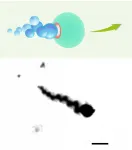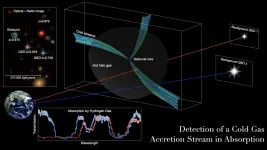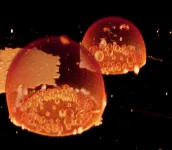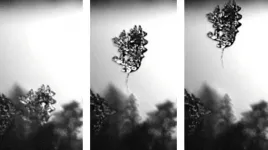(Press-News.org) Researchers have developed a method to estimate the value of oyster and clam aquaculture to nitrogen reduction in a coastal community. Nitrogen is a nutrient that comes from many different sources, including agriculture, fertilizers, septic systems, and treated wastewater. In excess it fuels algal growth, which can affect water quality and human health.
As a result, a growing number of communities are required to follow regulations to reduce the amount of nitrogen they release. Shellfish are an option that can be a valuable part of a community's nutrient management plan.
In a study in Environmental Science & Technology, shellfish biologists, economists, and modelers from NOAA Fisheries, NOAA National Centers for Coastal Ocean Science, and Stony Brook University used a transferable replacement cost methodology to estimate the value of oyster and clam aquaculture to nitrogen reduction in Greenwich, Connecticut.
Growing bivalve shellfish, including oysters and clams, provides direct economic benefits to a community by supporting jobs and making fresh local seafood available to consumers. It also provides ecosystem services - benefits that nature provides to people - including habitat for native species and improved water quality.
"When we started discussing this work, I had a long list of ecosystem services in mind -- not just nitrogen remediation, but water clarity for swimming and seagrass colonization, habitat for recreational fish -- all leading to improved quality of life in a coastal town," said Gary Wikfors, chief of the aquaculture sustainability branch at the Northeast Fisheries Science Center's Milford Laboratory in Milford, Connecticut, and a co-author of the study. "As a biologist, I learned from this study how complex a comprehensive economic valuation is! The economic benefit estimates in this report are just a small fraction of the total -- the tip of the iceberg -- but still appreciable at the municipal level."
Clams and oysters take up nutrients when they filter feed on algae. Some of those nutrients become part of their shells and tissue, and are taken out of the watershed when shellfish are harvested. This benefits the watershed, because excess nutrients can fuel overgrowth of algae, causing blooms, fish kills, and other negative outcomes that can affect ecosystems and human health.
Shellfish can be a valuable part of a community's nutrient management plan because they efficiently take up nitrogen. Estimating the dollar value of those water quality benefits requires a multidisciplinary approach.
What is the economic value of water quality improvements?
More than half of the local nitrogen input in Greenwich is nonpoint source, such as runoff from lawn fertilizer. The rest is point source input, such as treated wastewater. Nonpoint source input is often more challenging and expensive to reduce than point source input, requiring a multifaceted strategy.
Using a transferable replacement cost methodology, the researchers found that replacing the nutrient removal benefits of shellfish aquaculture in Greenwich with traditional engineered nutrient reduction strategies would cost between $2.8-5.8 million per year. The estimate assumes the use of a combination of wastewater treatment improvements, septic system upgrades, and stormwater best management practices in proportion to the local nitrogen sources.
Clam and oyster aquaculture removes approximately 9% of the total locally-deposited nitrogen from Greenwich Bay annually, or about 31,000 lbs of nitrogen per year. The percentage removed is even greater when considering only nitrogen from nonpoint sources (16%), fertilizer (28%) or septic sources (51%). Per-acre nitrogen removal for oyster aquaculture was higher because oysters are grown more densely, but clams contributed more to nutrient reduction because more clams are harvested overall.
Shellfish are unique because they take up nitrogen across all sources, whether from lawn fertilizer, deposition from the atmosphere, or treated wastewater. Residents of the community benefit from shellfish aquaculture whether or not they eat oysters, as they enjoy improved water quality and taxpayers can save money.
Developing a transferable approach
The team developed two ways to estimate the value of shellfish. One is appropriate for a well-established shellfish aquaculture industry and estimates nitrogen removal from the annual harvest. The second allows ecosystem managers to project the nitrogen removal of a new or growing industry.
"We developed a method to estimate potential harvest in communities with limited or no current aquaculture, but with opportunities to expand or start aquaculture, to highlight possibilities," said project co-lead Suzanne Bricker from NOAA's National Centers for Coastal Ocean Science.
The approach detailed in this study can be applied to other communities wishing to reduce nutrients to improve water quality. Whether or not they have an existing shellfish aquaculture industry, local decision makers will find useful information about the environmental benefits of shellfish to their coastal waters. "There is growing interest in coastal communities around the United States in shellfish aquaculture, and our hope is that the approach we developed here can help inform local discussions about aquaculture around the country," said project co-lead Julie Rose from the NOAA Northeast Fisheries Science Center's Milford Laboratory.
Greenwich as a case study
A coastal community with a thriving shellfish aquaculture industry, Greenwich served as an ideal case study for the nutrient reduction benefits of shellfish. Between aquaculture, recreational areas, and seed beds, approximately 60% of the seafloor in Greenwich is used for shellfish activities.
Partnerships with two local shellfish growers, Atlantic Clam Farms and Stella Mar Oyster Company, were crucial to this study. The companies provided data on their annual shellfish harvest and local aquaculture practices, which researchers used to model the amount of nitrogen removed.
The shellfish industry in Greenwich has been supported by an active municipal shellfish commission for more than 30 years. The Greenwich Shellfish Commission made local field logistics possible and plans to include these findings in their ongoing education and outreach efforts.
"Our commission assisted by providing access to field sites and pinpointing locations for sampling. When we're involved in a NOAA project, it's an educational experience," said Roger Bowgen, Greenwich Shellfish Commissioner, "The more we learn, the more we can explain to coastal homeowners and the general public when we engage them in conversations about shellfish aquaculture. It's a chain of discussion: everyone tells someone else."
INFORMATION:
A UNSW Sydney-led medical research team has called for a new vaccine, improved strategies and enhanced monitoring to combat serious complications from childhood pneumonia.
The researchers examined the impact of the 13-valent pneumococcal conjugate vaccine (13vPCV) on childhood pneumonia and empyema - complicated pneumonia - after its introduction to the Australian National Immunisation Program about a decade ago.
The new study, published in Thorax recently, found that while 13vPCV resulted in a 21 per cent decrease in childhood pneumonia hospitalisations, there was a contemporaneous 25 per cent increase in admissions for empyema.
This incidence data for childhood empyema hospitalisations is similar to that reported ...
For many, 2020 was notorious for the COVID-19 pandemic, but for climate scientists, the year is also infamous for tying with 2016 as the hottest since records began. 'Nine of the warmest years on record have occurred since 2010', says JEB Editor-in-Chief, Craig Franklin. With the ice caps and glaciers melting, devastating bushfires scorching arid regions, and hurricanes and typhoons battering coastal communities, the impact on local ecosystems has been catastrophic. 'Physiologists can play a critical role in the conversation around climate change', says ...
As part of the Journal of Experimental Biology's Special Issue dedicated to climate change, Anthony Pagano (San Diego Zoo Global, USA) and Terrie Williams (University of California, Santa Cruz, USA), discuss the impact of environmental change on two iconic polar species; the polar bear and narwhal. Their review article is published in Journal of Experimental Biology at https://jeb.biologists.org/content/224/Suppl_1.
Mammals in the Polar Regions face an uncertain future as unprecedented warming drives catastrophic sea ice loss, driving polar bears onto land, after losing access to sea ice and ...
Rheumatoid arthritis is a chronic inflammatory disorder marked by joint pain, swelling and damage. Although medications, such as steroids, anti-inflammatory drugs and immunosuppressants, can help slow joint destruction and relieve pain, they have side effects and aren't completely successful. Now, researchers reporting in ACS' Nano Letters have developed magnesium-based micromotors propelled by hydrogen bubbles, which improved rheumatoid arthritis symptoms when injected into the joints of rats.
Scientists have linked rheumatoid arthritis development to the excess production of reactive oxygen species (ROS). ROS can oxidize and degrade cartilage and bone, as well as activate the expression of inflammatory cytokines. A new type of therapy, hydrogen gas, can neutralize ROS ...
To come into being, galaxies need a steady diet of cold gases to undergo gravitational collapse. The larger the galaxy, the more cold gas it needs to coalesce and to grow.
Massive galaxies found in the early universe needed a lot of cold gas--a store totaling as much as 100 billion times the mass of our sun.
But where did these early, super-sized galaxies get that much cold gas when they were hemmed in by hotter surroundings?
In a new study, astronomers led by the University of Iowa report direct, observational evidence of streams of cold gas they believe provisioned these early, massive galaxies. They detected cold gas pipelines that knifed through the hot atmosphere in the dark matter halo of an early massive galaxy, supplying the materials ...
New research by the University of Oslo provides evidence that the "protocells" that formed around 3.8 billion years ago, before bacteria and single-celled organisms, could have had specialized bubble-like compartments that formed spontaneously, encapsulated small molecules, and formed "daughter" protocells.
ROCKVILLE, MD - Scientists have long speculated about the features that our long-ago single-celled ancestors might have had, and the order in which those features came about. Bubble-like compartments are a hallmark of the superkingdom to which we, and many other species including yeast, belong. But the cells in today's superkingdom have a host of specialized molecules that help make and shape these bubbles inside our ...
ATLANTA - FEBRUARY 24, 2021 - New study reports that early in the 2020 pandemic in the United States, one-third of cancer survivors worried about treatment and cancer care disruptions. Using a mixed methods approach, investigators utilized survivors' own words to more deeply describe their experiences and worries about the pandemic's impact on their overall health.
The article, appearing in the Journal of Psychosocial Oncology, finds the impact of the pandemic on cancer survivors and the broader health care system is widespread and exacerbated serious gaps in the health care system. For this study, investigators led by Corinne Leach, MPH, MS, PhD, from the American ...
If you have ever gotten up on a winter morning and thrown yourself into the arduous task of scraping frost from a windshield, a Virginia Tech lab is engaging science [IS1] that could make your life much easier. In research funded by the National Science Foundation, Associate Professor END ...
DALLAS, Feb. 24, 2021 -- Postmenopausal women who ate high levels of plant protein had lower risks of premature death, cardiovascular disease and dementia-related death compared with women who ate less plant proteins, according to new research published today in the Journal of the American Heart Association, an open access journal of the American Heart Association.
Previous research has shown an association between diets high in red meat and cardiovascular disease risk, yet the data is sparse and inconclusive about specific types of proteins, the study authors ...
In the largest genome-wide association study of glaucoma comparing the genes of 34,179 people with the disease to 349,321 control subjects, an international consortium of researchers identified 44 new gene loci and confirmed 83 previously reported loci linked to glaucoma. Loci are considered "genetic street addresses," denoting a specific location on a gene.
The study's authors hope the identification of these genes will lead to new treatment targets for this incurable eye disease that is a leading cause of blindness worldwide.
"These new findings come out of the highest-powered genome-wide association study of glaucoma to date, and show the power of team science and using big data to answer questions when research groups around the world join forces," said co-senior study author ...



